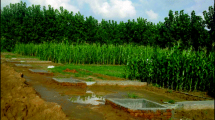Abstract
Runoff calculation is one of the key components in the hydrological modeling. For a certain spatial scale, runoff is a very complex nonlinear process. Currently, the runoff yield model in different hydrological models is not unique. The Chinese LCM model and the American SCS model describe runoff at the macroscopic scale, taking into account the relationship between total actual retention and total rainfall and having a certain similarity. In this study, by comparing the two runoff yield models using theoretical analyses and numerical simulations, we have found that: (1) the SCS model is a simple linear representation of the LCM model, and the LCM model reflects more significantly the nonlinearity of catchment runoff. (2) There are strict mathematical relationships between parameters (R, r) of the LCM model and between parameters (S) of the SCS model, respectively. Parameters (R, r) of the LCM can be determined using the research results of the SCS model parameters. (3) LCM model parameters (R, r) can be easily obtained by field experiments, while SCS parameters (S) are difficult to measure. Therefore, parameters (R, r) of the LCM model also can provide the foundation for the SCS model. (4) The SCS model has a linear relationship between the reciprocal of total actual retention and the reciprocal of total rainfall during runoff period. The one-order terms of a Taylor series expansion of the LCM model describe the same relationship, which is worth further study.
Similar content being viewed by others
References
Chen J Q, 1966. Estimation of Small Watershed Peak Discharge Resulting from Storm Rainfall, Report. Beijing: Hydro-Electric Publishing. (in Chinese)
Cronshey R, 1986. Urban hydrology for small watersheds. US Dept. of Agriculture, Soil Conservation Service, Engineering Division.
Hicks W I, 1944. A method of computing urban runoff. Trans. Amer. Soc. Civil Eng., 109: 1217–1253.
Liu Changming, Bai Peng, Gong Tongliang et al., 2013. Estimation of peak flow of an ungauged basin in Tibetan Plateau. South to North Water Transfers and Water Science & Technology, 11(1): 1–6. (in Chinese)
Liu Changming, Hong Baoxin, Zeng Mingxuan et al., 1965. The experimental research of the predicting relationship of storm runoff on Loess Plateau. Chinese Science Bulletin, 2(2): 158–160. (in Chinese)
Liu Changming, Wang Guangte, 1980. The estimation of small-watershed peak flows in China. Water Resources Research, 16(5): 881–886.
Liu Changming, Wang Zhonggen, Zheng Hongxing et al., 2008. Application study of HIMS system and custom model. Science in China (Series E: Technological Sciences), 38(3): 350–360. (in Chinese)
Liu Changming, Zheng Hongxing, Wang Zhonggen et al., 2010. The hydrological process of HIMS integrated simulation based on multi scale. Journal of Beijing Normal University (Natural Science Edition), 46(3): 268–273. (in Chinese)
Liu Changming, Zhong Junxiang, 1978. Preliminary analysis of effects of forest on runoff in Loess Plateau. Acta Geographica Sinica, 33(2): 112–126. (in Chinese)
Liang Kang, Liu Changming, Wang Zhonggen et al., 2012. Runoff simulation in the Heiyukou sub-basin of the Weihe River Basin and its responses to climate change based on HIMS. Yellow River, (10): 13–14. (in Chinese)
McCuen R H, 1982. A Guide to Hydrologic Analysis Using the SCS Methods. Prentice-Hall, Inc.., 145p.
Mishra S K, Singh V P, 1999. Another look at the SCS-CN method. J. Hydrol. Eng., 4(3): 257–264.
Mishra S K, Singh V P, 2002a. SCS-CN-based hydrologic simulation package, Ch. 13. In: Singh V P, Frevert D K (eds). Mathematical Models in Small Watershed Hydrology and Applications, Water Resources Publications, P.O. Box 2841, Littleton, CO 80161, 391–464.
Mishra S K, Singh V P, 2002b. SCS-CN method. Part I: Derivation of SCS-CN based models. Acta Geophys. Pol., 50(3): 457–477
Mishra S K, Singh V P, 2003. Soil Conservation Service Curve Number (SCS-CN) Methodology. Dordrecht, The Netherlands: Kluwer.
Mishra S K, Singh V P, 2004a. Long-term hydrological simulation based on the soil conservation service curve number. Hydrol. Process, 18(7): 1291–1313
Mishra S K, Singh V P, 2004b. Validity and extension of the SCS-CN method for computing infiltration and rainfall-excess rates. Hydrol. Process., 18: 3323–3345.
Moore I D, Grayson R B, Ladson A R, 1991. Digital terrain modeling: A review of hydrological, geomorphological and biological applications. Hydrological Processes, 5(1): 3–30.
Patil J P, Sarangi A, Singh A K et al., 2008. Evaluation of modified CN methods for watershed runoff estimation using a GIS-based interface. Biosystems Engineering, 100(1): 137–146.
Reyes M R, Green C H, Arnold J G, 2007. The soil and water assessment tool: Historical development, applications, and future research directions. Center for Agricultural and Rural Development, Iowa State University.
SCS, 1956. Hydrology. National Engineering Handbook, Supplement A, Section 4 Chapter 10, Soil Conservation Service. Washington: DC USDA.
SCS, 1971. Hydrology National Engineering Handbook. Section 4, Chapter 10, Soil Conservation Service. Washington, DC: USDA.
SCS, 1985. Hydrology. National Engineering Handbook, Supplement A, Section 4 Chapter 4, Soil Conservation Service. Washington, DC: USDA.
SCS, 2004. http://www.wcc.nrcs.usda.gov/hydro/hydro-techref-neh-630-html.
USDA, 1986. Urban hydrology for small watersheds. Tech release 55, Natural Resources Conservation Service, US Dept of Agriculture.
Wang Zhonggen, Zheng Hongxing, Liu Changming, 2005. Based distributed hydrological modeling system and its application modules. Progress in Geography, 24(6): 109–115. (in Chinese)
Wang Zhonggen, Zheng Hongxing, Liu Changming et al., 2004. Application study of the distributed hydrological model in the Yellow River typical watershed. Science in China (Series E: Science and Technology), 34(Suppl.I): 49–59. (in Chinese)
Author information
Authors and Affiliations
Corresponding author
Additional information
Foundation: National Natural Science Foundation of China, No.41271048; The Key Program of National Natural Science Foundation of China, No.41330529
Author: Li Jun (1968–), PhD Candidate, specialized in hydrology and water resources.
Liu Changming, Professor, specialized in hydrology and water resources.
Rights and permissions
About this article
Cite this article
Li, J., Liu, C., Wang, Z. et al. Two universal runoff yield models: SCS vs. LCM. J. Geogr. Sci. 25, 311–318 (2015). https://doi.org/10.1007/s11442-015-1170-2
Received:
Accepted:
Published:
Issue Date:
DOI: https://doi.org/10.1007/s11442-015-1170-2




